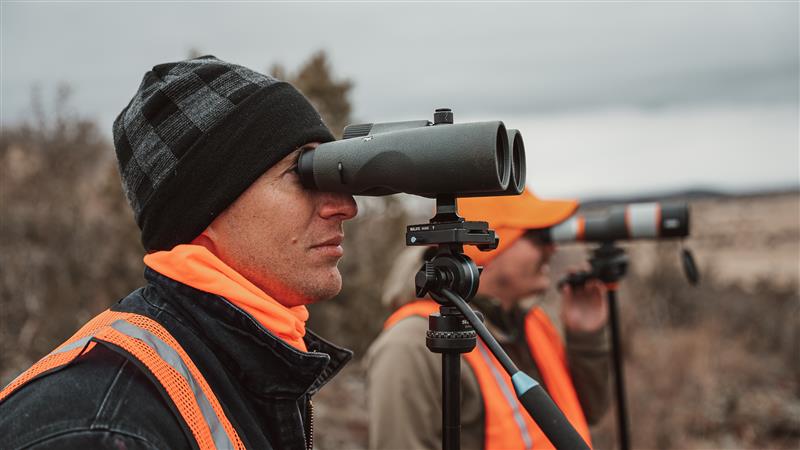Habitat Work Means More Deer in Your Spotting Scope

By Michael “Mickey” Luby
Ask any seasoned hunter what makes for a great mule deer season, and you’ll likely hear the same answers: good weather, time to scout, a solid tag — and deer. Lots of deer.
What some hunters overlook, though, is that seeing more mule deer doesn’t just come down to luck or draw odds. It comes down to habitat — and behind that habitat, there’s often a crew of conservationists, biologists, and volunteers working to make the ground better for deer and the people who hunt them. That’s where the Mule Deer Foundation (MDF) steps in.
Habitat Projects That Help Hunters
Mule deer are tied to the land in a way that’s easy to overlook from behind a spotting scope. Their health, survival, and visibility, especially during hunting season, depend on habitat quality. When the land provides good forage, water, cover, and space to move, deer thrive. When it doesn’t, they vanish.
In Nevada, the MDF-backed Mule Deer Enhancement Program (MDEP) has spearheaded more than 25 habitat-focused projects in just a few years. These include reseeding after wildfires, removing invasive cheatgrass, improving water availability, and restoring native shrubs. That work matters. In 2023, for the first time in years, spring fawn recruitment numbers in Nevada crept above average thanks to better winter moisture and improved forage conditions.
Now, that might sound like a win for biologists, but make no mistake, it’s a win for hunters too. More fawns mean more bucks in future seasons. Better forage means healthier does. And healthy herds mean higher success rates for all of us willing to put in the miles.
Forest Management and Mountain Deer
Out West, especially in states like Montana and Idaho, MDF and partners are tackling a different kind of challenge: thick, overgrown forest. When fire is suppressed for too long, forests turn into dark, dense stands of conifer with little understory growth. That’s bad news for mule deer, who rely on edge habitat, open meadows, and a mix of shrubs and forbs for nutrition.
Forest management projects — things like prescribed burns, thinning, and aspen stand regeneration — open up the canopy, letting light hit the ground and kickstart a flush of vegetation that deer hammer in spring and fall. These same projects also improve visibility for hunters and make for better glassing conditions. It’s no coincidence that where forest management happens, hunters start seeing more deer.
MDF doesn’t just talk about this work, we fund it, plan it, and put boots on the ground to make it happen.
Real Results in the Field
You don’t have to take my word for it. In areas where MDF habitat projects have taken root, local hunters are starting to notice. Increased deer sightings, better buck-to-doe ratios, and healthier-looking herds are becoming more common, not overnight, but consistently over time.
And the work keeps expanding. In the Columbia Plateau, Northern Great Basin, and Mojave regions, current moisture patterns paired with recent habitat efforts are expected to result in strong conditions for mule deer in the years ahead. That means more fawns making it through winter, more deer on the landscape, and more chances for hunters to fill their tags.
Conservation = Opportunity
Here’s the truth: you don’t see more deer just because you bought better optics or pulled a lucky tag. You see more deer because someone fought to keep the land wild, the water flowing, and the habitat intact. That “someone” is often the Mule Deer Foundation.
If you hunt mule deer or want your kids to have that same chance, I’d ask you to get involved. Every membership, every dollar, every volunteer hour helps restore the kind of habitat that supports strong herds and successful hunts.
Because when the ground is healthy, the deer show up. And when the deer show up, the stories and the memories follow.
Help us keep deer on the mountain and in your scope. Join the Mule Deer Foundation today.
Let’s keep the West wild and full of deer.
Join the Mule Deer Foundation!
Send any success pictures or stories from the field to [email protected] and you could be featured on our website or in our magazine. If this article or any of our articles have helped you become a better hunter or conservation steward, consider becoming a member of the Mule Deer Foundation or the Blacktail Deer Foundation or both. Click here to join: https://muledeer.org/product-category/membership/ or https://www.blacktaildeer.org/

Michael “Mickey” Luby – Writer Bio
Michael “Mickey” Luby is a modern-day mountain man and unapologetic traditionalist living deep in Western Montana. A seasoned mule deer hunter with decades of experience chasing high-country bucks, Mickey has earned a reputation for grit, stubbornness, and a sixth sense for finding big deer where the air is thin and the trails are long forgotten.



